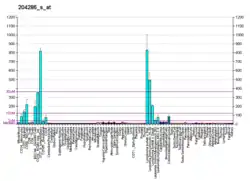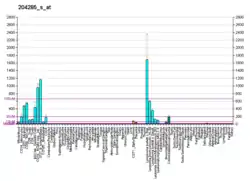Phorbol-12-myristate-13-acetate-induced protein 1
Phorbol-12-myristate-13-acetate-induced protein 1 is a protein that in humans is encoded by the PMAIP1 gene, and is also known as Noxa.[3][4][5]
Noxa (Latin for damage) is a pro-apoptotic member of the Bcl-2 protein family.[6] Bcl-2 family members can form hetero- or homodimers, and they act as anti- or pro-apoptotic regulators that are involved in a wide variety of cellular activities. The expression of Noxa is regulated by the tumor suppressor p53, and Noxa has been shown to be involved in p53-mediated apoptosis.
Interactions
Noxa has been shown to interact with:
See also
- Apoptosis
- Apoptosome
- Bcl-2
- Bcl-2-associated X protein (BAX)
- BH3 interacting domain death agonist (BID)
- Caspases
- Cytochrome c
- Mitochondrion
- p53 upregulated modulator of apoptosis (PUMA)
- 12-O-Tetradecanoylphorbol-13-acetate (Phorbol-12-myristate-13-acetate)
References
- GRCh38: Ensembl release 89: ENSG00000141682 - Ensembl, May 2017
- "Human PubMed Reference:". National Center for Biotechnology Information, U.S. National Library of Medicine.
- Hijikata M, Kato N, Sato T, Kagami Y, Shimotohno K (October 1990). "Molecular cloning and characterization of a cDNA for a novel phorbol-12-myristate-13-acetate-responsive gene that is highly expressed in an adult T-cell leukemia cell line". J Virol. 64 (10): 4632–9. doi:10.1128/JVI.64.10.4632-4639.1990. PMC 247947. PMID 2398525.
- Jansson AK, Emterling AM, Arbman G, Sun XF (July 2003). "Noxa in colorectal cancer: a study on DNA, mRNA and protein expression". Oncogene. 22 (30): 4675–8. doi:10.1038/sj.onc.1206655. PMID 12879012.
- "Entrez Gene: PMAIP1 phorbol-12-myristate-13-acetate-induced protein 1".
- Oda E, Ohki R, Murasawa H, Nemoto J, Shibue T, Yamashita T, Tokino T, Taniguchi T, Tanaka N (May 2000). "Noxa, a BH3-only member of the Bcl-2 family and candidate mediator of p53-induced apoptosis". Science. 288 (5468): 1053–1058. Bibcode:2000Sci...288.1053O. doi:10.1126/science.288.5468.1053. PMID 10807576.
- Chen L, Willis SN, Wei A, Smith BJ, Fletcher JI, Hinds MG, Colman PM, Day CL, Adams JM, Huang DC (February 2005). "Differential targeting of prosurvival Bcl-2 proteins by their BH3-only ligands allows complementary apoptotic function". Mol. Cell. 17 (3): 393–403. doi:10.1016/j.molcel.2004.12.030. PMID 15694340.
- Oda E, Ohki R, Murasawa H, Nemoto J, Shibue T, Yamashita T, Tokino T, Taniguchi T, Tanaka N (May 2000). "Noxa, a BH3-only member of the Bcl-2 family and candidate mediator of p53-induced apoptosis". Science. 288 (5468): 1053–8. Bibcode:2000Sci...288.1053O. doi:10.1126/science.288.5468.1053. PMID 10807576.
- Willis SN, Chen L, Dewson G, Wei A, Naik E, Fletcher JI, Adams JM, Huang DC (June 2005). "Proapoptotic Bak is sequestered by Mcl-1 and Bcl-xL, but not Bcl-2, until displaced by BH3-only proteins". Genes Dev. 19 (11): 1294–305. doi:10.1101/gad.1304105. PMC 1142553. PMID 15901672.
- Heckmeier, Philipp J.; Ruf, Jeannette; Janković, Brankica G.; Hamm, Peter (7 March 2023). "MCL-1 promiscuity and the structural resilience of its binding partners". The Journal of Chemical Physics. 158 (9). doi:10.1063/5.0137239.
Further reading
- Oda E, Ohki R, Murasawa H, Nemoto J, Shibue T, Yamashita T, Tokino T, Taniguchi T, Tanaka N (2000). "Noxa, a BH3-only member of the Bcl-2 family and candidate mediator of p53-induced apoptosis". Science. 288 (5468): 1053–8. Bibcode:2000Sci...288.1053O. doi:10.1126/science.288.5468.1053. PMID 10807576.
- Seo YW, Shin JN, Ko KH, Cha JH, Park JY, Lee BR, Yun CW, Kim YM, Seol DW, Kim DW, Yin XM, Kim TH (2004). "The molecular mechanism of Noxa-induced mitochondrial dysfunction in p53-mediated cell death". J. Biol. Chem. 278 (48): 48292–9. doi:10.1074/jbc.M308785200. PMID 14500711.
- Kim JY, Ahn HJ, Ryu JH, Suk K, Park JH (2004). "BH3-only protein Noxa is a mediator of hypoxic cell death induced by hypoxia-inducible factor 1alpha". J. Exp. Med. 199 (1): 113–24. doi:10.1084/jem.20030613. PMC 1887730. PMID 14699081.
- Yakovlev AG, Di Giovanni S, Wang G, Liu W, Stoica B, Faden AI (2004). "BOK and NOXA are essential mediators of p53-dependent apoptosis". J. Biol. Chem. 279 (27): 28367–74. doi:10.1074/jbc.M313526200. PMID 15102863.
- Qin JZ, Stennett L, Bacon P, Bodner B, Hendrix MJ, Seftor RE, Seftor EA, Margaryan NV, Pollock PM, Curtis A, Trent JM, Bennett F, Miele L, Nickoloff BJ (2005). "p53-independent NOXA induction overcomes apoptotic resistance of malignant melanomas". Mol. Cancer Ther. 3 (8): 895–902. doi:10.1158/1535-7163.895.3.8. PMID 15299072. S2CID 34940117.
- Flinterman M, Guelen L, Ezzati-Nik S, Killick R, Melino G, Tominaga K, Mymryk JS, Gäken J, Tavassoli M (2005). "E1A activates transcription of p73 and Noxa to induce apoptosis". J. Biol. Chem. 280 (7): 5945–59. doi:10.1074/jbc.M406661200. PMID 15572378.
- Chen L, Willis SN, Wei A, Smith BJ, Fletcher JI, Hinds MG, Colman PM, Day CL, Adams JM, Huang DC (2005). "Differential targeting of prosurvival Bcl-2 proteins by their BH3-only ligands allows complementary apoptotic function". Mol. Cell. 17 (3): 393–403. doi:10.1016/j.molcel.2004.12.030. PMID 15694340.
- Sun Y, Leaman DW (2005). "Involvement of Noxa in cellular apoptotic responses to interferon, double-stranded RNA, and virus infection". J. Biol. Chem. 280 (16): 15561–8. doi:10.1074/jbc.M412630200. PMID 15705586.
- Ceballos E, Muñoz-Alonso MJ, Berwanger B, Acosta JC, Hernández R, Krause M, Hartmann O, Eilers M, León J (2005). "Inhibitory effect of c-Myc on p53-induced apoptosis in leukemia cells. Microarray analysis reveals defective induction of p53 target genes and upregulation of chaperone genes". Oncogene. 24 (28): 4559–71. doi:10.1038/sj.onc.1208652. PMID 15856024.
- Willis SN, Chen L, Dewson G, Wei A, Naik E, Fletcher JI, Adams JM, Huang DC (2005). "Proapoptotic Bak is sequestered by Mcl-1 and Bcl-xL, but not Bcl-2, until displaced by BH3-only proteins". Genes Dev. 19 (11): 1294–305. doi:10.1101/gad.1304105. PMC 1142553. PMID 15901672.
- Alves NL, Derks IA, Berk E, Spijker R, van Lier RA, Eldering E (2006). "The Noxa/Mcl-1 axis regulates susceptibility to apoptosis under glucose limitation in dividing T cells". Immunity. 24 (6): 703–16. doi:10.1016/j.immuni.2006.03.018. PMID 16782027.
- Obexer P, Geiger K, Ambros PF, Meister B, Ausserlechner MJ (2007). "FKHRL1-mediated expression of Noxa and Bim induces apoptosis via the mitochondria in neuroblastoma cells". Cell Death Differ. 14 (3): 534–47. doi:10.1038/sj.cdd.4402017. PMID 16888645.
- Fribley AM, Evenchik B, Zeng Q, Park BK, Guan JY, Zhang H, Hale TJ, Soengas MS, Kaufman RJ, Wang CY (2006). "Proteasome inhibitor PS-341 induces apoptosis in cisplatin-resistant squamous cell carcinoma cells by induction of Noxa". J. Biol. Chem. 281 (42): 31440–7. doi:10.1074/jbc.M604356200. PMID 16928686.
- Smit LA, Hallaert DY, Spijker R, de Goeij B, Jaspers A, Kater AP, van Oers MH, van Noesel CJ, Eldering E (2007). "Differential Noxa/Mcl-1 balance in peripheral versus lymph node chronic lymphocytic leukemia cells correlates with survival capacity". Blood. 109 (4): 1660–8. doi:10.1182/blood-2006-05-021683. PMID 17038534.
- Armstrong JL, Veal GJ, Redfern CP, Lovat PE (2007). "Role of Noxa in p53-independent fenretinide-induced apoptosis of neuroectodermal tumours". Apoptosis. 12 (3): 613–22. doi:10.1007/s10495-006-0020-1. PMID 17216584. S2CID 41674871.
- Doffo J, Bamopoulos SA, Köse H, Orben F, Zang C, Pons M, et al. (2022). "NOXA expression drives synthetic lethality to RUNX1 inhibition in pancreatic cancer". Proc Natl Acad Sci USA. 119 (9). Bibcode:2022PNAS..11905691D. doi:10.1073/pnas.2105691119. PMC 8892327. PMID 35197278.
External links
- NOXA+protein,+human at the U.S. National Library of Medicine Medical Subject Headings (MeSH)
This article is issued from Wikipedia. The text is licensed under Creative Commons - Attribution - Sharealike. Additional terms may apply for the media files.



